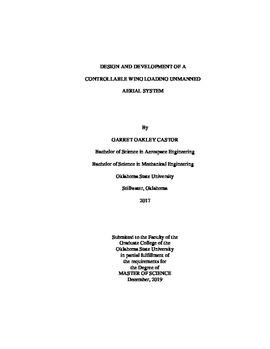| dc.contributor.advisor | Arena, Andy | |
| dc.contributor.author | Castor, Garret Oakley | |
| dc.date.accessioned | 2020-04-09T21:00:08Z | |
| dc.date.available | 2020-04-09T21:00:08Z | |
| dc.date.issued | 2019-12 | |
| dc.identifier.uri | https://hdl.handle.net/11244/323829 | |
| dc.description.abstract | Vertical takeoff and landing (VTOL) unmanned aerial systems (UAS) offer all the benefits of wing borne flight without the need for conventional takeoff and landing (CTOL) infrastructure. There exists many effective VTOL UAS that utilize battery-powered rotors to provide vertical thrust. The problem with the existing UAS is that the VTOL capability is achieved at the sacrifice of speed, fuel/payload, and operational flexibility. Also, many of these UAS must transition from hover to horizontal flight which is both complex and risky. | |
| dc.description.abstract | The current research explores a new type of point launch and landing system that utilizes only liquid fuels, i.e. no electric powered rotors. Instead of exposed rotors, the new configuration has a turbojet engine mounted vertically inside the fuselage to provide vertical thrust. With the turbojet being 'hidden' from the freestream air, it mitigates the drag seen from the other configurations' rotors, allowing a higher top speed. Also, the new configuration bypasses the hover and transition phases of flight. | |
| dc.description.abstract | The vertical turbojet effectively changes the weight of the aircraft which allows it to have controllable wing loading (CWL), and therefore variable stall speed. With the jet at full power, the aircraft weighs virtually nothing and can takeoff from the launchpad with almost no airspeed. Likewise, on landing, the aircraft can slow to almost zero airspeed and land with little to no rollout. The CWL configuration has proved it possible to have approximately a 95% reduction in landing distance. | |
| dc.description.abstract | This paper describes the study, design, manufacturing, and testing of the point launch and landing CWL configuration. Two commercial off the shelf (COTS) UAVs were retrofitted with a CWL system to test the validity of the idea and the necessary systems. | |
| dc.description.abstract | Following the proof of the idea, a composite UAS with a maximum takeoff weight of 50 lb. was designed, manufactured, and flown. It successfully demonstrated both a point launch and point landing while being capable of reaching speeds of up to 100 mph, more than double the top speed of some other VTOL UAS in its weight class. | |
| dc.format | application/pdf | |
| dc.language | en_US | |
| dc.rights | Copyright is held by the author who has granted the Oklahoma State University Library the non-exclusive right to share this material in its institutional repository. Contact Digital Library Services at lib-dls@okstate.edu or 405-744-9161 for the permission policy on the use, reproduction or distribution of this material. | |
| dc.title | Design and development of a controllable wing loading unmanned aerial system | |
| dc.contributor.committeeMember | Gaeta, Rick | |
| dc.contributor.committeeMember | Rouser, Kurt | |
| osu.filename | Castor_okstate_0664M_16564.pdf | |
| osu.accesstype | Open Access | |
| dc.type.genre | Thesis | |
| dc.type.material | Text | |
| dc.subject.keywords | point landing | |
| dc.subject.keywords | point launch | |
| dc.subject.keywords | uas | |
| dc.subject.keywords | v/stol | |
| dc.subject.keywords | vtol | |
| thesis.degree.discipline | Mechanical and Aerospace Engineering | |
| thesis.degree.grantor | Oklahoma State University | |
